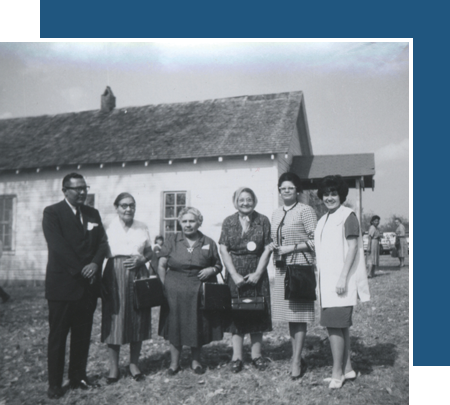
In October 1960 more than 100 Chickasaws rallied to reestablish a tribal government at Seeley Chapel. During the historical watershed event, the Chickasaw people discussed tribal business and the future of the Chickasaw Nation planting seeds of progress nurtured by a 1950s grassroots movement, known today as the Seeley Chapel movement. Leaders were determined to reclaim and revitalize tribal government and improve the state of health care.
Year after year, Chickasaws continued to gather socially and in churches in the belief that community involvement and support would sustain them. The Chickasaw language was spoken, and traditional activities were practiced whenever and wherever possible. This gathering would grow into an annual tradition of fellowship and cultural celebration that continues to reconnect and unify Chickasaws.
Today, it is known as the Chickasaw Annual Meeting.
View Timeline
A continuing legacy of self-determination
Throughout the 1960s, the Chickasaw people continued to fight for the recognition of their sovereign rights, including the right to elect tribal officials. Meetings took place at Seeley Chapel and Kullihoma. The annual gathering continued to grow in attendance through the 1970s and relocated to Byng High School near Ada.
In 1971, thanks in part to the efforts of the Seeley Chapel movement, the Chickasaw Nation had its first gubernatorial election since 1904, electing Overton James as Governor.
"The 1979 Chickasaw Annual Meeting was monumental for the future of the Chickasaw Nation."
With a united, democratic voice, the Chickasaw Nation began to see progress toward a promising future. In an effort to keep Chickasaws up to date and maintain the grassroots spirit of the Seeley Chapel movement, the Chickasaw Annual Meeting provides an opportunity to detail tribal progress and future plans, through Governor’s State of the Nation Address.
The 1979 Chickasaw Annual Meeting was monumental for the future of the Chickasaw Nation with the reelection of Governor Overton James and the inauguration of the first Lt. Governor of the Chickasaw Nation, Bill Anoatubby.

The Chickasaw Annual Meeting and Festival
The location has shifted over time, moving from Connerville to Byng to Tishomingo. Sites have included Seeley Chapel, Byng School Auditorium, under a tent on the Capitol grounds and more recently in Fletcher Auditorium at Murray State College.
In the years since that first Chickasaw Annual Meeting in 1960, events and activities were planned around the event, including the Princess Pageant, the Southeastern Art Show and Market, and various cultural and sport activities.
Anoatubby was elected Governor of the Chickasaw Nation in 1987 and focused the tribe’s efforts on elders, economic development, education, health care and housing.
The Chickasaw Festival was merged with the Chickasaw Annual Meeting in 1992 and relocated to Tishomingo, our historic capital city and site of the Chickasaw Nation Historic Capitol Building. The Chickasaw Annual Meeting and Festival offers a weeklong celebration which culminates with the State of the Nation address – a testament to the representative and accountable government sought by the intrepid Chickasaws who started the Seeley Chapel movement.
"The Chickasaw Annual Meeting and Festival is a time of reflection and celebration."
The Chickasaw Annual Meeting and Festival was part of Governor Anoatubby’s vision to help revitalize Chickasaw culture, expand opportunities for economic development, such as tourism, and continue building our relationship with our historic capital city, Tishomingo, site of the Chickasaw Nation Historic Capitol Building.
Through it all, Chickasaw Annual Meeting has been a time for Chickasaw citizens to share news and to hear reports from the Governor and tribal officials on the state of the Chickasaw Nation.

Coming together
During the 1990s, the development of new programs and services began to flourish. Cultural revitalization was ignited and citizenship and voter registration numbers began to increase. More and more Chickasaws began to reconnect with their cultural heritage.
Today, the Chickasaw Annual Meeting and Festival is a time of reflection and celebration. The yearly event gives Chickasaw people an opportunity to celebrate culture, heritage and history, and to look toward the future.